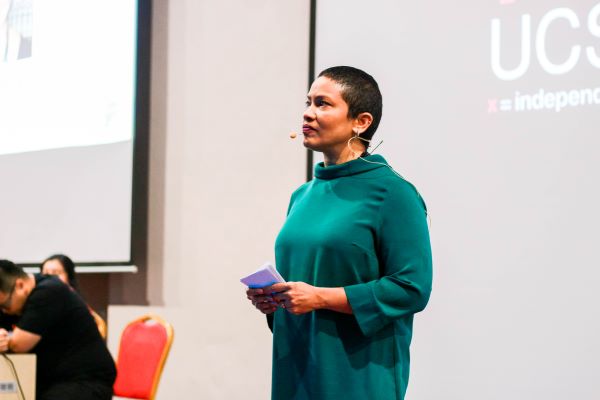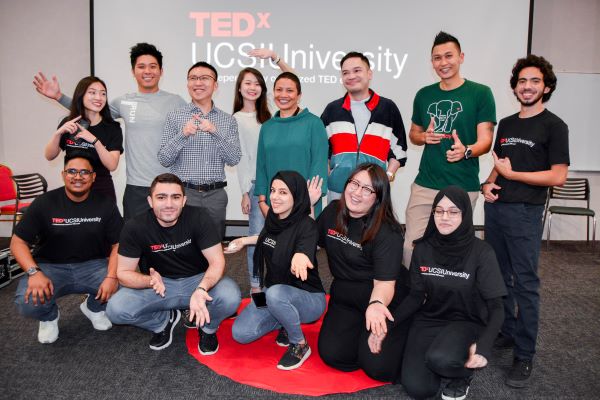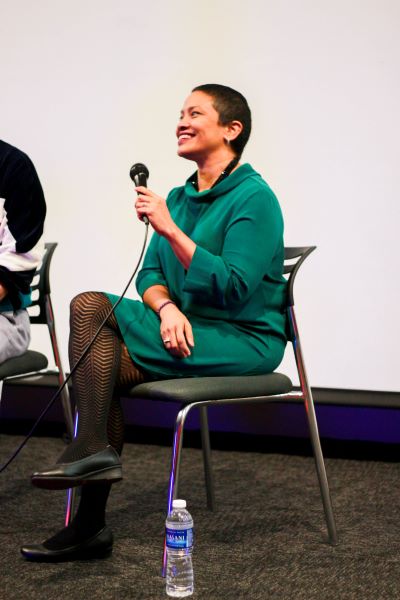
Theme: Mavericks and Misfits. The ones who create are the ones who challenge the existing system, the ones who have courage to dream and the will to pursue them.
This is the transcript from the TEDx talk I delivered at TEDx UCSI in March 2019.
I’d like you for just a moment to dream.
Close your eyes if that makes it a little bit easier for you. I’d like you to dream about the big dream that you’ve got, about the things that matter to you. The things that you know are rocking and rolling around in your head and just let it sit with you for a while.
Then I want you to see if you notice yourself wandering away in your mind’s eye. Do you start to worry about the things that could go wrong? Are you thinking about the how-tos and all of the possible obstacles that may come your way?
We spend so much more of our time and our energy focused on all the things that can go wrong in our life, far more than the things that can go right.
It’s natural. We spend so much more of our time and our energy focused on all the things that can go wrong in our life, far more than the things that can go right. So I’d like to share something that I think is truly powerful that can help you move forward… help you take things to the next level.
Unfetter your dream.
So I have three ideas that I’d like to share with you today. The first is, what does it mean to unfetter your dream? The second is why should you do this? And finally, how would you go about doing something like this?
To unfetter your dream is to really dream with a blank slate. It’s to put aside all of your obstacles, all the limitations that you can see. I mean, you will come to that eventually but you’re going to focus on your dream first. You’re going to put some shape and some context and structure around what it is that you’re trying to come up with.
You know, you’re not going to make any assumptions and what I’m asking you to do I know is fairly difficult, especially if you’re doing something that is completely new. You’re doing something where you don’t have people ahead of you to kind of guide you …. or anyone who has forged a path. But I really think that it is important that you allow yourself, that you give yourself that permission to dream big.
It boils down to context and experiences.
So it is really important to open yourself up to new experiences, new ways of thinking, new people, cultures and a whole bunch of things that are alien to you in some way. And the more that you can do this, the more that you can fully tap into this fragile, vulnerable side of yourself, the side that is really wanting to do something big, something monumental, something exciting.
So to unfetter your dream is really to say to yourself, “I’ve got all of these things coming at me, all of these things that are going to kind of unsettle and unhinge me but I’m not going to let it. I’m going to protect this dream.”
It’s hard to do this because everything will or it will seem like everything around you will begin to crowd and dim that dream whether it’s people, friends, peers, colleagues or bosses. It might be just circumstances or just the generally accepted way of doing things. They will come around your dream and begin to cloud it, dim it, maybe even cut it down.
So to unfetter your dream is really to say to yourself, “I’ve got all of these things coming at me, all of these things that are going to kind of unsettle and unhinge me but I’m not going to let it. I’m going to protect this dream.” You’re going to do that because this dream is fragile. It’s in its infancy and it needs that time to develop, to grow and to strengthen.
So let me share what I mean by all of this, by giving you a little bit of my background, my story.
I started a publishing business many years ago with no prior editing, writing or publishing experience. We had a small team and we all had different roles. I was fairly uncertain of the path ahead of me. I was scared. I didn’t know what was ahead. And I didn’t have a lot of mentors or people to guide me in what we were trying to do.
I looked at that situation and I said to myself, “There are two ways that I could go about doing this. I could either look at this and say I want to do this but I don’t know how and so I’m going to quit. Or I could just say I’m going to just do it and I’ll take it one day at a time.”
And that’s exactly what I did.
I had a very small team but don’t get me wrong. I did none of this by myself. It was the collective effort, all of us in together to make the dream come true, to make what we are today. The majority were working on the revenue generating aspects of the business and my job was to focus on the content piece, the branding, marketing and communications. Looking back now, there are a couple of things that I feel really helped me to get to where I needed to be, the first of which is I had an appetite for high risk projects. I was willing to fail.
The way I looked at it, I was very focused on what it is that I wanted to do. So all of these different things that were coming in, they were just stuff that I had to deal with and get out of the way and I had to move ahead. The second thing is that I learned how to be comfortable with being uncomfortable, which is to say, that I took myself out of my comfort zone.
I learned very publicly. I failed. In fact, I failed more times in my life that I’ve been successful. But that has got me to where I am and I just moved on. I fell down, I got up. I picked myself up and I carried on. I didn’t dwell.
The third thing is the phrase by Ryan Holiday – ‘the obstacle is the way’. I just saw that there was no way that I was going to get to the ‘smart side’, the ‘done side’, the side of accomplishment just watching everybody else, just thinking about it and reading about it. I actually had to go through all of those things to get to the other side.
So then the question is, ‘Why should you do this?’ It’s very simple to me.
You only have this one shot. You owe it to yourself to be confident about who you are and what you’re capable of. It’s much easier, I think, to derail yourself with negativity. It’s much easier to tell yourself it’s not going to work. To just cave and quit.
But to hold on to that dream that you have, that you’re protecting…. it takes courage. It takes persistence and you will feel alone at times, you will. But that’s okay. That’s okay because I feel that my world has really opened up ever since I started having bold plans.
It is my experience and I know that this idea of the universe aligning with you might not sit well with some people, be seen as ‘airy fairy’ stuff. But it has been my experience that when I have clarity about what it is that I want to do and then I put it out there, I find things start to happen, opportunities start to bubble up. I start to meet the people that I find appropriate for whatever it is I’m trying to do. Situations start to change and things start to move in a positive, proactive direction. There’s a lot of good energy that comes from it.
I didn’t need to wait until I was diagnosed with cancer last year to come to this conclusion. So that’s the other ironic thing – that for many people it takes a catastrophe to kind of truly live. When I was diagnosed with breast cancer last year, I said, ‘OK, so now what? What am I going to do that is more of the same? And then, what am I going to do that is going to be radically different?’
And it was intriguing. I found that I was doing more of the same. On some higher level, I found that there was very little that I was willing to change, that I was happy and aligned with where I wanted to be.
You’ve only got this one shot and I know that these are words, you know, up here, but I truly believe that you have to make these words a reality yourself. You’ve got to go out and you’ve got to make these dreams happen. You’ve got to push yourself and make yourself happy and fulfil yourself. And the hard part is only you can figure out what that means for yourself.
Only you …whether you have a support system around you, friends and family or peers or on the flip side, you don’t have a support network around you.
This is a process, a journey that you’re going to have to take yourself. So then the question is, ‘OK. I get it, I’m on board. Now, how do I go about doing this?’
So there are a couple of things that I have done through the years that worked for me and that I believe can also work for you.
The first is that I believe you need to really flex that resilience muscle. I was tested. I am regularly being tested. I have failed many times. But you just pick yourself up.
I had clarity, as I said, about my direction. I knew what I wanted to do and what I needed to do. And I just went and did it. And everything else was just par for the course.
The second thing is you’ve got to take a long term view of things, which I think is really hard in today’s environment. Real time. Real time, everything. Instant gratification. Very social media driven. I think it’s very easy to have your ideas pushed around. It’s very easy to have other people’s ideas shoved down your throat. But I still think that you can find a way to kind of quieten all of this down long enough for you to hear your voice.
Third, through all of the struggles in my career or in my personal life, I come back to ‘the obstacle is the way’. I saw that all of these things that I was facing were just necessary. It was there. It was in front of me. I just had to deal with it. The quicker that I could deal with those things, the quicker I could then face the landscape that I was dealing with and solve whatever challenges were in my way.
Fourth, I think you’ve got to develop a support system for yourself. You’ve got to develop that support system so that is people, process and things. It pained me last year to see how public my struggle with cancer was going to be. It pained me, as a private person, to see all of these intrusions into my privacy and all of these questions. But at the same time, I also know that there are many people out there who are facing similar struggles and some, far worse than this. And I knew that they needed support. So I chose to provide the support that I myself was getting from those around me, family and friends. l created systems, processes and things to help me do what I needed to do. I leveraged social media and effectively, I asked for help. I asked for help and I got it.
Fifth, you’ve got to allow yourself to fail. I think that’s something that I came to terms with a long time ago. You’ve got to have just a little bit of a risk appetite and allow yourself to fail because nothing… nothing happens in that comfort zone.
Six, you’ve got to have a plan. I’m a little bit of a planner, so I like to look in and around the problem. I like to come up with various contingencies and scenarios that I need to examine. But I also know that things take time. It takes time for me to do what I’m doing. It takes time for things to happen and you’ve got to give yourself that time. You’ve got to give yourself that opportunity and not quit at the first sign of trouble.
Seven, and I’ll end here, because I could go on and on. I think this is the most critical part. It’s all about choice. We all like to think that often we don’t have a choice but we do. Sometimes, we just don’t like the choices that we’re presented with… but there you go. We do have choice.
So unfetter your dream and just begin.
If you like this post, I hope you will share it. If you need help with your writing, with getting published or with strengthening your brand, feel free to reach out.
#dreambig #career #goals #influence #purpose #TEDx
This is the transcript from the TEDx talk I delivered at TEDx UCSI in March 2019. TED is a nonprofit devoted to spreading ideas, usually in the form of short, powerful talks (18 minutes or less). TED began in 1984 as a conference where Technology, Entertainment and Design converged, and today covers almost all topics — from science to business to global issues — in more than 100 languages. A TEDx event is a local gathering where live TED-like talks and videos previously recorded at TED conferences are shared with the community. TEDx events are fully planned and coordinated independently, on a community-by-community basis.





Pingback: Develop Your Elevator Pitch – Digital Confluence